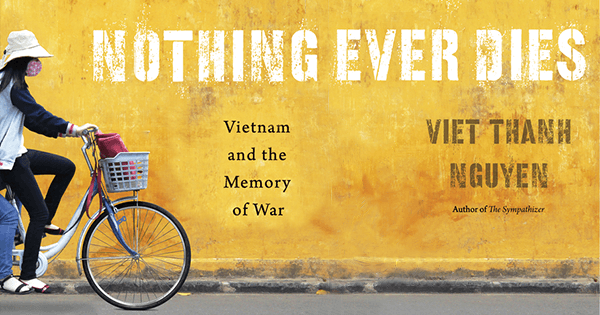Nothing Ever Dies
Read an excerpt from Viet Thanh Nguyen’s new book about Vietnam and the memory of war

The Vietnam War—or, as those on the other side of the trenches would call it, the American War—remains fraught terrain, more than 40 years after the fall of Saigon. Viet Thanh Nguyen, whose last book, The Sympathizer, considered the experience of the war through fiction, returns here to nonfiction. “All wars are fought twice,” he writes, “the first time on the battlefield, the second time in memory.” Nguyen ventures beyond the traditional borders of the Vietnam War to examine its mushrooming effects in Laos, Cambodia, and South Korea, while considering our conception of war in general.
Read an excerpt from the first chapter of Nguyen’s book, where he parses the first thing anyone learns about a war: its name.
Each war has a distinct identity, a face with carefully drawn features, familiar at a glance to the nation’s people. The tendency is to remember any given war, to the extent it is remembered at all, for a detail or two. Hence, World War II is the “Good War” for many Americans, while the tragedy in Vietnam is the bad war, a syndrome, a quagmire, a stinging loss in need of healing and recuperation. The inclination is to remember wars like individuals, separate and distinct. Wars become discrete events, clearly demarcated in time and space by declarations of war and ceasefires, by the inscription of dates in history books, news articles, and memorial placards. And yet all wars have murky beginnings and inconclusive endings, oftentimes continuing a preceding war and foreshadowing a later one. These wars often do not take place only in the territories for which they are named, but spill over into neighboring countries; they are also shaped in war rooms and boardrooms distant from the battlefields. Wars are as complex as individuals, but are remembered by names that tell us as little as the names of individuals do. The Philippine- American War implies symmetry between two nations, yet it was Americans who seized the Philippines and instigated the carnage. The Korean War implies a conflict between Koreans, when China and the United States did more than their fair share of the fighting. In the case of the Vietnam War, Americans invented the name, an odd handcuffing of two nouns that has become normal through constant repetition. So normal, in fact, that even if the name is abbreviated to Vietnam, as it so often is, many people still understand it to mean the war. In response, many have protested that Vietnam is a country, not a war. But long before this cry, some of the Vietnamese (the ones who eventually won) had already begun calling it the American War. Still, if the Vietnam War is an inadequate name in the sense that it misleads us about the war’s identity, is the American War any better?
This name excuses the various ways in which Vietnamese of all sides also own the war, from its triumphs and its disasters to its glories and its crimes. Not least the name encourages Vietnamese people to think of themselves as victims of foreign aggression. As victims, they are conveniently stricken with amnesia about what they did to one another and how they extended their war westwards into Cambodia and Laos, countries that a unified Vietnam would strive to influence, dominate, and even invade in the postwar era.
These ambivalent meanings of the American War are matched by those found in the Vietnam War. While that name has come to represent American defeat and humiliation, there are also elements of American victory and denial, for the name limits the war’s scale in space and time. When it comes to space, either name effaces how more than just Vietnamese or Americans fought this war, and how it was fought both inside and outside of Vietnam. When it comes to time, other American wars preceded it (in the Philippines, the Pacific Islands, and Korea), occurred at the same time (in Cambodia, Laos, and the Dominican Republic), and followed it (in Grenada, Panama, Kuwait, Iraq, and Afghanistan). These wars were part of a century-long effort by the United States to exert its dominion over the Pacific, Asia, and eventually the Middle East— the Orient, broadly defined. Two landmark years bracketed this century. In 1898, America seized Cuba, the Philippines, Puerto Rico, and Hawaii, inaugurating an overseas expansion of American interests that ran into unexpected resistance in 2001, with 9/11 and the ensuing conflicts in the Middle East. The real American War was this entire American Century, a long and uneven expansion marked by a few periodic high-intensity conflicts, many low-intensity skirmishes, and the steady drone of a war machine’s ever- ongoing preparations. The result is that “war time has become normal time in America.”
From Nothing Ever Dies: Vietnam and the Memory of War by Viet Thanh Nguyen.
Copyright © 2016 by Viet Thanh Nguyen. Used by Permission. All rights reserved.

